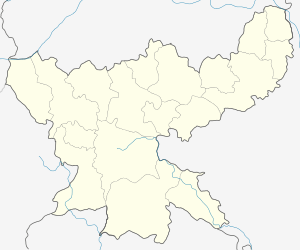East Bokaro Coalfield
| Location | |
|---|---|
 Bokaro Coalfield Location in Jharkhand | |
| State | Jharkhand |
| Country | India |
| Coordinates | 23°48′N 85°45′E / 23.800°N 85.750°ECoordinates: 23°48′N 85°45′E / 23.800°N 85.750°E |
| Owner | |
| Company | Central Coalfields Limited |
| Website | http://ccl.gov.in/ |
| Year of acquisition | 1975 |
East Bokaro Coalfield is located in Hazaribagh and Bokaro districts in the Indian state of Jharkhand.
Overview
In 1917, L.S.S.O’Malley described the coalfields in the upper reaches of the Damodar as follows: “Near the western boundary of Jharia field is that of Bokaro, covering 220 square miles (570 km2), with an estimated content of 1,500 million tons; close by… is the Ramgarh field (40 square miles), in which, however, coal is believed to be of inferior quality. A still larger field in the same district is that called Karanpura, which extends over 544 square miles (1,410 km2) and has an estimated capacity of 9,000 million tons.”[1]
The Coalfield
The Bokaro coalfield lies between 230 45’ and 230 50’ North latitude and 850 30’ and 860 03’ East longitude. It spreads 65 km from east to west and 10 to 16 km from north to south. Bokaro West and Bokaro East are two subdivisions of the field separated almost in the middle by Lugu Hill (height 960.9 m).[2]
Bokaro River passes through the West Bokaro and East Bokaro coalfields.[3][4]
East Bokaro Coalfield covers an area of 208 square kilometres (80 sq mi) and has total coal reserves of 4,473.66 million tonnes.[5]
Transport
In 1927, the Central India Coalfields Railway opened the Gomoh-Barkakana line. It was extended to Daltonganj in 1929. Later these lines were amalgamated with East Indian Railway.[6]
References
- ↑ L.S.S. O’Malley, Bengal, Bihar and Orissa, Sikkim, p.87, Cambridge University Press, 1917 (paper back 2011) ISBN 978-1-107-60064-5
- ↑ S.M.Casshyap. "A Reflectance Study of Certain Coals from the Bokaro Coalfield, Bihar" (PDF). University of Aligarh. Retrieved 2008-08-26.
- ↑ "Water pollution in Bokaro River". Supreme Court. Retrieved 2010-05-03.
- ↑ "The real face of the Tatas: a Tata rap sheet". Retrieved 2010-05-03.
- ↑ Prasoon Kumar Singh, Gurdeep Singh and Brajendra Kumar Tiwary. "Critical Evaluation of Geo-Environmental Scenario of Damodar River Basin, Inia" (PDF). Retrieved 2008-08-26.
- ↑ "Indian Railway History Timeline". Retrieved 2008-08-26.